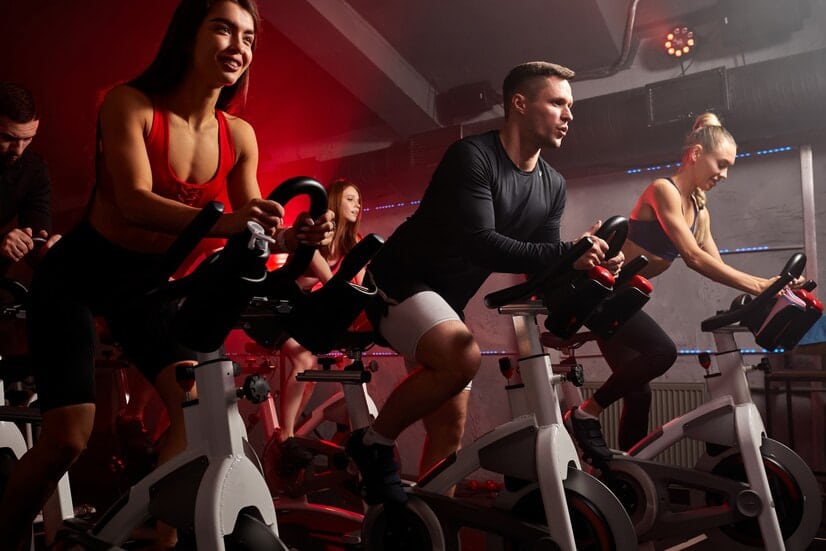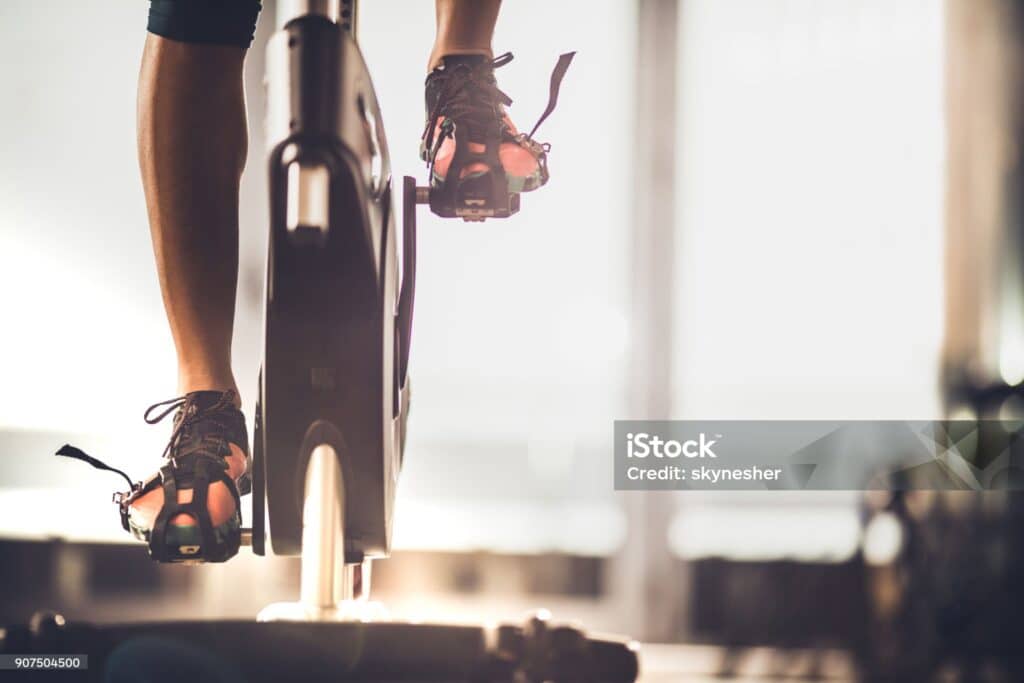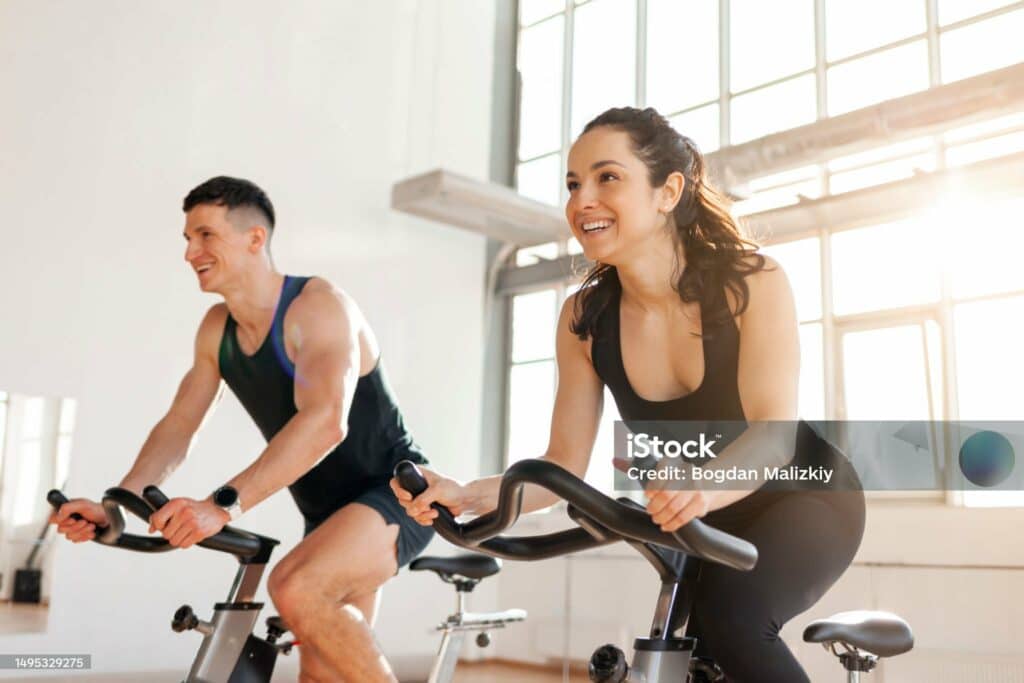
Summary
Welcome » Welcome » Tips for getting started » RPM benefits: discover the benefits of this practice
RPM benefits: discover the benefits of this practice
Le RPM, ou cyclisme indoor, est une méthode d’entraînement populaire pour améliorer votre forme physique. Conçu pour simuler des parcours variés, il combine cardio et renforcement musculaire en suivant le rythme de la musique. Cet article vous explique tout ce que vous devez savoir sur les bienfaits du RPM.
You will discover how RPM improves endurance, strengthens muscles and helps with weight loss. We will also compare RPM to other activities and give you practical advice on how to get started and progress effectively.
Wondering if RPM is right for you? This article is here to answer all your questions and guide you in your practice.
Summary
What is RPM? (indoor bike)
Definition and origins
Definition of RPM (Indoor bike)
RPM, or “Raw Power in Motion,” is a form of indoor cycling training that is done on a stationary bike that is part of the family of gym bikes and apartment. This program, structured in group sessions, is designed to simulate varied courses, such as climbs and sprints, under the guidance of a qualified instructor. The main goal of RPM is to improve general fitness through cardio and muscle strengthening exercises. You pedal to the rhythm of the music, which makes the workout motivating and dynamic.
Origins and history of RPM
RPM was developed in the 1990s by the Les Mills company in New Zealand. The idea was born from the desire to offer intense and accessible training to everyone, regardless of initial fitness level. Since its creation, RPM has grown in popularity and has become an essential discipline in gyms around the world. The programs are regularly updated to offer ever more effective and entertaining sessions.
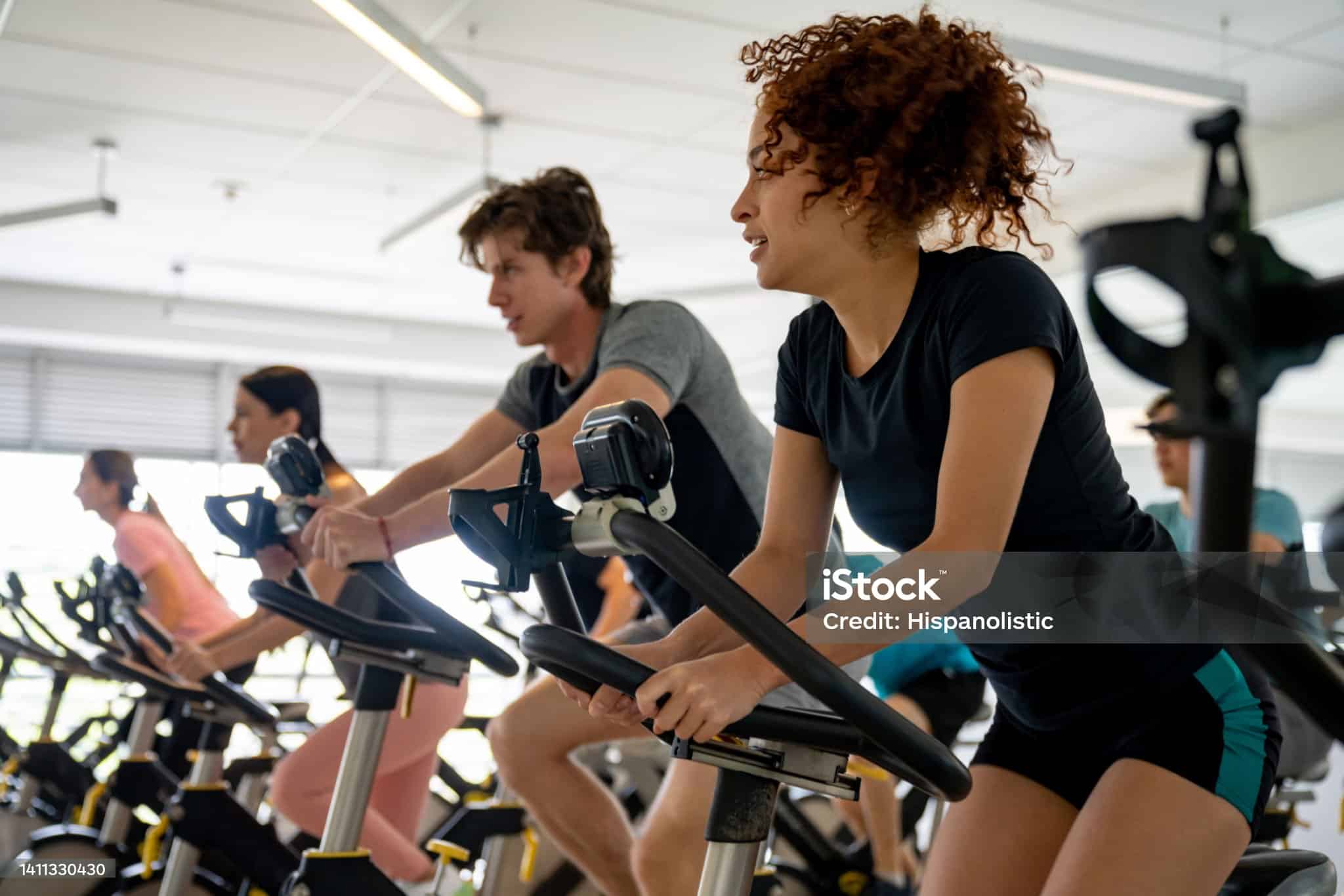
Necessary equipment
Exercise bike or spinning bike
To practice RPM, a specific exercise bike, often called a spinning bike, is necessary. These bikes are designed to withstand intense sessions and allow personalized adjustments to the saddle and handlebars for optimal comfort. They are equipped with resistance systems that simulate different terrains, increasing the difficulty of the workout as needed.
Suitable shoes
Cycling shoes are recommended for optimal RPM practice. They feature rigid soles and cleats that attach to the bike's pedals, providing better power transmission and secure foot support. Opt for comfortable, well-fitting shoes to avoid injuries and maximize your performance.
Appropriate sports attire
To be comfortable during RPM sessions, it is essential to wear suitable sports clothing. Choose breathable, fitted clothing, such as cycling shorts with a padded seat and lightweight jerseys. Don't forget a towel to blot up sweat and a bottle of water to stay hydrated throughout the workout.
The health benefits of RPM
Cardiovascular benefits
Improved cardiovascular endurance
RPM is excellent for improving cardiovascular endurance. By pedaling at varying intensities, your heart works harder to pump blood, which strengthens the cardio-respiratory system. Over the course of the sessions, you will notice an increase in your ability to sustain prolonged efforts without running out of breath. You will therefore have more endurance, not only on the bike, but also in your daily activities.
Strengthening the heart muscle
By practicing RPM regularly, you strengthen your heart muscle. Sessions of varying intensity, from tough climbs to fast sprints, force your heart to adapt and become more powerful. A stronger heart improves blood circulation, allowing your muscles and organs to be better oxygenated. It also contributes to better overall health and reduced risk of cardiovascular disease.
Regulation of blood pressure
RPM helps regulate blood pressure. Dynamic endurance exercises stimulate blood circulation and promote dilation of vessels, thereby reducing blood pressure. Studies show that people who regularly engage in cardio activities like RPM have more stable blood pressure and reduced stress levels, which is beneficial for long-term heart health.
Muscle benefits
Strengthening leg muscles
RPM intensely works the leg muscles, particularly the quadriceps, hamstrings and calves thanks to programs designed for leg workout. When pedaling, these muscles are constantly in action, which strengthens and tones them. Over the course of the sessions, you will notice an increase in muscle power and endurance, making activities like walking or climbing stairs easier.
Toning your abs and arms
Although RPM is primarily a leg exercise, it also works the abs and arms. Maintaining good posture on the bike engages the core muscles, while using the arms to stabilize your position also strengthens the biceps and triceps. Thus, RPM offers a complete workout, contributing to a harmonious and well-toned body.
Improved posture and balance
RPM improves posture and balance. By maintaining a correct position on the bike, you strengthen the stabilizing muscles of the back and trunk. This helps prevent lower back pain and improve your overall posture. Additionally, the balance needed to pedal effectively transfers these benefits to your daily life, reducing the risk of falls and accidents.
Benefits for weight loss
High calorie expenditure
RPM is a great way to burn calories. An intensive RPM session can burn between 400 and 600 calories, depending on your weight and the intensity of the effort. This high calorie expenditure contributes to weight loss, especially when combined with a balanced diet. It is an ideal choice for those looking to shed a few extra pounds.
Increased metabolism
By practicing RPM regularly, you stimulate your metabolism. Intense training increases basal metabolic rate, which means you continue to burn calories even after your session is over. This increase in metabolism helps maintain a healthy weight and prevent long-term weight gain.
The advantages of RPM compared to other activities
Low impact on joints
Comparison with running
RPM stands out for its low impact on the joints, unlike running. While pedaling, your feet remain in constant contact with the pedals, reducing shock to the knees, hips and ankles. Running, on the other hand, can cause repetitive trauma to these joints, especially on hard surfaces. If you're looking for an effective cardio exercise without risking joint injuries, RPM is a great option.
Suitable for people with joint problems
Thanks to its low impact, RPM is particularly suitable for people with joint problems, such as arthritis or previous injuries. The fluid movements of cycling help strengthen the muscles around the joints without overstressing them. This can help improve mobility and reduce pain, while providing an effective cardiovascular workout.
Full Body Workout
Cardiovascular and muscular work
RPM effectively combines cardiovascular and muscular work. In addition to strengthening your heart and improving your endurance, it intensely works the muscles of the legs, abdominals and upper body. This combination makes it a complete exercise, unlike other activities which may focus mainly on one aspect or the other. RPM allows you to simultaneously develop your strength and general physical condition.
Possibility of varying the intensities
One of the great advantages of RPM is the possibility of varying intensities. Whether you're a beginner or an experienced athlete, you can adjust the resistance and pedaling cadence to match your level and goals. This flexibility allows you to progress at your own pace and personalize each session to maximize benefits. Sessions can range from active recovery to high-intensity workouts, offering a diversity of exercises to avoid monotony.
Motivation and atmosphere
Group lessons with an instructor
RPM classes are often taught in a group with an instructor, which creates a motivating and dynamic atmosphere. The instructor guides the session, corrects postures and encourages participants to surpass themselves. This social interaction and mutual support between participants makes training more enjoyable and stimulating. This makes you more likely to maintain a regular practice and achieve your fitness goals.
Groovy music
Music plays a crucial role in RPM sessions. Each class is punctuated by a dynamic and motivating playlist that helps you keep the rhythm and surpass yourself. Synchronizing your movements with the music makes training more fun and less monotonous. Music can also improve your mood and reduce the perception of effort, making each RPM session an enjoyable and anticipated one.
How to practice RPM effectively?
Preparation before a session
Warming up
Before starting an RPM session, it is crucial to warm up properly. A good warm-up prepares your muscles and heart for exercise, reducing the risk of injury. Start with 5 to 10 minutes of light pedaling, gradually increasing the intensity. Add some dynamic stretches for your legs, hips and back. You will then be ready to give the best of yourself from the start of the session.
Hydration
Hydration is essential for optimal RPM performance. Make sure to drink water before, during and after training. Proper hydration maintains your energy levels, helps regulate body temperature and promotes recovery. Keep a bottle of water handy and take small sips regularly throughout the session.
Adapted equipment
To practice RPM effectively, suitable equipment is essential. Use a spinning bike that is well adjusted to your body shape: the height of the saddle and handlebars must be correct to avoid pain. Wear cycling shoes for better grip and optimal power transfer. Breathable and comfortable sports clothing will help you stay dry and comfortable during exercise.
Pedaling techniques
Position on the bike
A good position on the bike is essential to maximize your pedaling efficiency and avoid injury. Sit up straight with your shoulders relaxed and your elbows slightly bent. Keep knees in line with feet to minimize stress on joints. Adjust the saddle height so that your legs are almost fully extended when the pedals are at the lowest point.
Use of resistors
Varying resistances is key to effective RPM training. Use low resistances for recovery phases and higher resistances for climbs and sprints. Change resistance based on instructor guidance and your personal abilities. This variation allows you to work on both your endurance and your muscular strength.
Sync with music
Music is a central element of RPM. By synchronizing your pedaling with the musical rhythm, you make the workout more enjoyable and more effective. Music helps you maintain a good rhythm and stay motivated, especially during the most intense phases. Focus on the beats to adjust your cadence and maximize your effort while still having fun.
Recovery after a session
Stretching
After an RPM session, take the time to stretch well. Stretching helps release muscle tension and improve flexibility. Focus on the muscles being worked: quadriceps, hamstrings, calves, hips and lower back. Hold each stretch for at least 30 seconds to get the most benefit and promote recovery.
Hydration
Hydration after exercise is just as important as during it. Drink water to compensate for water loss due to sweating. You can also opt for isotonic drinks which help restore electrolyte balance. Proper hydration after training helps eliminate toxins and reduce muscle fatigue.
Adapted diet
A suitable diet is crucial to optimize post-RPM recovery. After training, eat protein-rich foods to help with muscle repair and carbohydrates to replenish energy stores. Choose balanced meals that include vegetables, fruits, whole grains and lean protein sources. Good post-workout nutrition promotes rapid recovery and prepares your body for upcoming sessions.
Tips for Beginners
Choose a suitable level
Beginner courses
To start RPM, it is important to choose courses suitable for beginners. These classes are designed to gradually introduce basic techniques and correct positions on the bike. They are less intense and allow you to learn at your own pace. Let your instructor know that you are a newbie so they can give you personalized advice and help you feel comfortable.
Adapt the intensity
As a beginner, it is crucial to adapt the intensity of your training. Don't feel like you have to keep up with more experienced participants. Adjust the bike resistance and cadence according to your fitness level. Start slowly and increase the intensity gradually. Listening to your body is essential to avoid injuries and get the most pleasure out of each session.
Progress gradually
Increase duration and intensity
Progression in RPM should be gradual. Start with short sessions, 30 to 45 minutes, and increase the duration as your endurance improves. Likewise, gradually increase the resistance and difficulty of the exercises. The idea is to constantly challenge your body without overworking it. You will see significant improvements in strength and endurance with well-measured progression.
Example of progress over several weeks
To illustrate effective progression, here is an example of a multi-week plan:
– Week 1-2 : 30 minute sessions with low resistance.
– Week 3-4 : Increase to 45 minutes, introduction of moderate resistance.
– Week 5-6 : 60-minute sessions, combinations of sprints and climbs with varied resistances.
– Week 7-8 : Exercise intensification, 60-minute sessions with high-intensity intervals.
This progression helps strengthen your endurance and muscles without overloading your body.
Stay motivated
Vary courses and instructors
To maintain your motivation, it is beneficial to vary the classes and instructors. Each instructor brings their own style and energy, which makes each session unique. Try different types of classes, like sessions focused on endurance, strength, or intervals. This diversity prevents routine from setting in and keeps you interested and engaged in the long term.
Define aims
Setting clear, achievable goals is a great way to stay motivated. Whether it's improving your fitness, losing weight, or simply feeling better about your body, having a goal gives you direction. Set short-term goals (like increasing resistance or completing a session without a break) and long-term goals (like participating in a cycling event). Tracking your progress will give you a sense of accomplishment and encourage you to keep going.
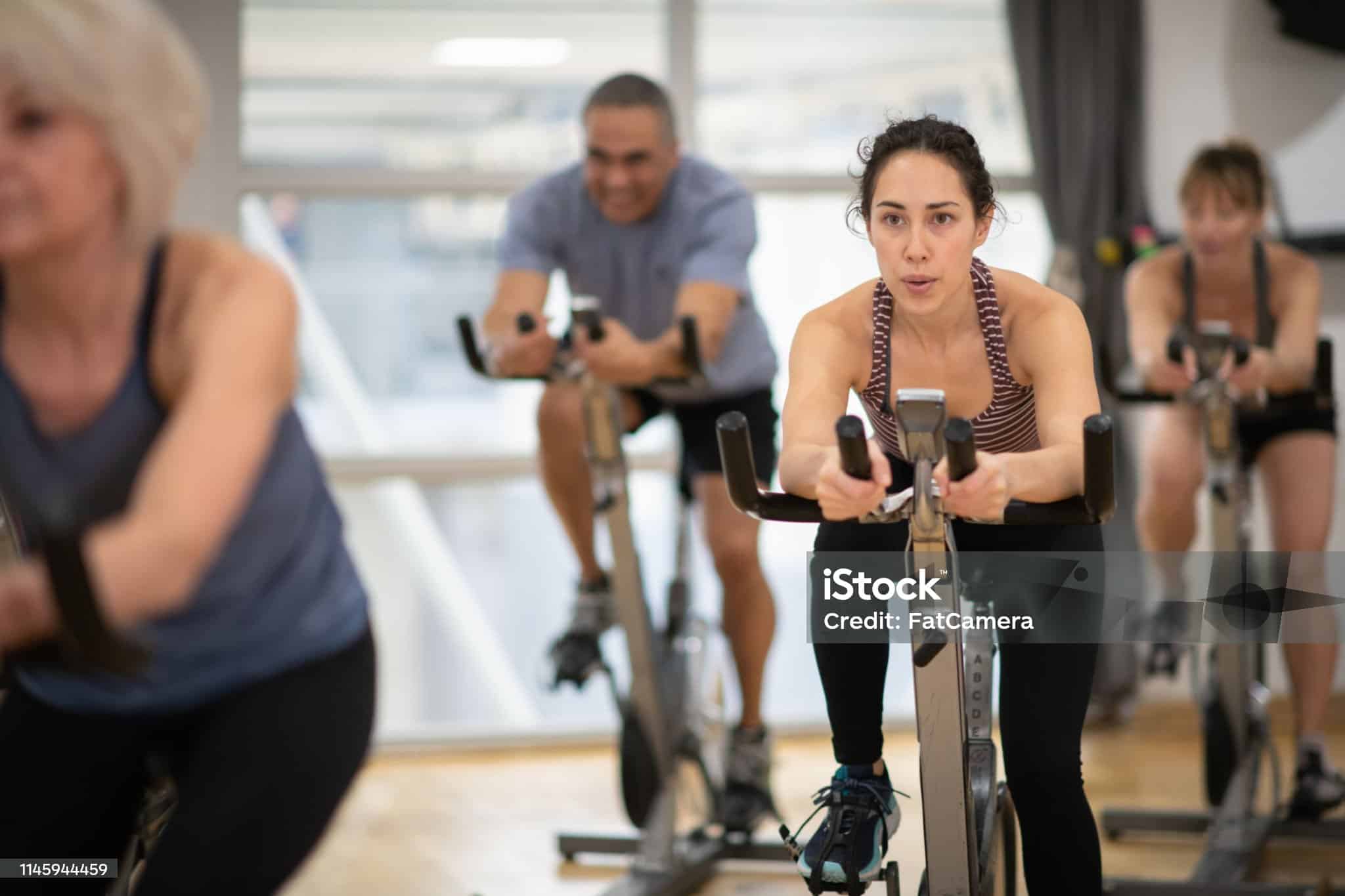
Conclusion
RPM is a great exercise to improve your fitness and overall well-being. It offers cardiovascular and muscular benefits and promotes weight loss. It is an ideal choice for a complete and motivating workout.
Compared to other activities, RPM has the advantage of having a low impact on the joints. It also allows you to vary the intensities and enjoy a stimulating atmosphere thanks to group classes and lively music. Practicing RPM effectively requires good preparation and appropriate pedaling techniques.
To go further, explore our articles on other indoor sports and discover tips for optimizing your fitness sessions. Continue to stay informed to maintain your motivation and achieve your health goals. You will find tips and practical guides to enrich your sports routine.
RPM like you've never seen it at SPACE CYCLE
Ready to get started? Discover RPM at SPACE CYCLE, through a unique experience! On the program, 45 minutes of immersive training in a subdued atmosphere, a spectacular light show and a supercharged group atmosphere.
Join us at Bonne Nouvelle or Bastille for an extraordinary sporting experience! Ready to take off?
Read also
RPM combien de fois par semaine : Guide pour optimiser vos séances
Vélo d’appartement bienfaits : pourquoi l’adopter dès maintenant ?
Follow us
on instagram
To follow all our news,
take advantage of our tutorials and participate
in our many contests.
Breaking news!
Receive our newsletter.
